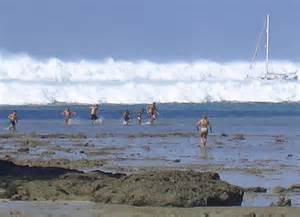Whether you live on the Oregon Coast or are just visiting, you need to be aware of tsunami siren protocol here in Florence. The tsunami sirens are intended to used as a warning when a distant tsunami approaches the shoreline. The primary focus of the sirens is to warn those who are outside in the inundation zone or those who are on the beach.
If you hear the REAL TIME evacuation tone, it is your signal to get to higher ground. This is a wail tone that varies from a low to high warble sound. There may be a window span of one to two hours for you to grab your emergency supplies and leave the inundation zone, but you must make the conscious decision ahead of time to leave the area when you hear this tone.
If you feel the earth shaking, get to higher ground immediately and do NOT wait for the sirens. An earthquake in the Florence area is an indicator that a tsunami will reach us in 10-15 minutes.
KCST Coast Radio 106.9 FM is the emergency broadcast station for Florence and its surrounding areas. They will provide further information on evacuations.
There are monthly siren tests conducted on the last Friday of each month, at 11:00 am. The test tone is a long, steady tone that will last one minute. It will be followed by the ‘all clear’ Westminster Chimes.
A tsunami is a series of enormous waves created by an underwater disturbance such as an earthquake, landslide, volcanic eruption, or meteorite. A tsunami can move hundreds of miles per hour in the open ocean and smash into land with waves as high as 100 feet or more. If a major earthquake or landslide occurs close to shore, the first wave in a series could reach the beach in a few minutes, even before a warning is issued. Areas are at greater risk if they are less than 25 feet above sea level and within a mile of the shoreline. Downing is the most common cause of death associated with a tsunami. Tsunami waves and the receding water are very destructive to structures in the run-up zone.
Other hazards include flooding, contamination of drinking water, and fire from gas lines or ruptured tanks. From the area where the tsunami originates, waves travel outward in all directions. Once the wave approaches the shore, it builds in height. The topography of the coastline and the ocean floor will influence the size of the wave. There may be more than one wave and the succeeding one may be larger than the one before. That is why a small tsunami at one beach can be a giant wave a few miles away.
A tsunami can occur any time of the day or in any time of the year. It will happen in coastal communities within the distance of a subduction zone. A tsunami is caused by an undersea earthquake. There are two kinds of tsunamis: one is a local event, the other is a distant event. The last local event in our area occurred in January 1700. In Oregon, geologists state that a local tsunami would occur every 300-500 years.

For more information check out these links: Oregon Department of Geology and Mineral Industries – Earthquakes in Oregon
Tsunami! Know How to Survive on the Oregon Coast (PDF) – Living on Shaky Ground – How to survive earthquakes and tsunamis in Oregon
Florence Area – Tsunami Evacuation Brochure (PDF) – Tsunami Evacuation Map Florence, Oregon
